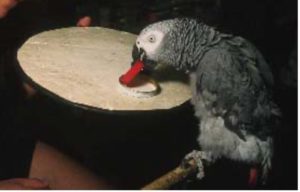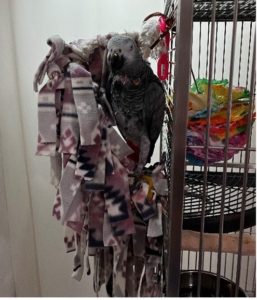Contents

We all know that providing our parrots with different types of toys improves their lives. Even my parrots, who spend a considerable amount of every day involved in research, also get plenty of time to play. But each individual bird has individual preferences, and it is important to recognize what actually is “fun” for a given bird. Just cluttering their cages with lots of stuff isn’t necessarily the best option, although that might be necessary initially until it is clear what types of toys are preferred.
Griffin, unlike most parrots, likes only one type of toy in his cage, and only a few other items elsewhere. We roll up several sheets of construction paper, feather the ends, tie the middle with a piece of rawhide, and fasten it to his cage. He’s 27 years old, and we’ve tried numerous other items…he pays attention to nothing else. However, when he’s on a flat surface, he loves to play with spoons. He rotates and flips them and seems to get quite a charge out of testing gravity—tossing the spoons off the edge of a surface and waiting for his human companions to pick them up and return them. He adores ‘spoon tickles’—when a human uses the spoon to gently scratch his head. He also likes to play with very small clear plastic cups and small jar lids, rolling them around and chewing on them; tossing them to the floor also seems to be fun.

Athena seemed to like many different objects at first, but we’ve learned that such is not the case. She does enjoy certain foraging toys and will prefer to use them to obtain the same food she can get for “free” from her food dishes. She loves to chew flannel. She does not, however, like to chew hard plastic. As for wood…well, we recently found that it has to be softwood! We noticed that she was ignoring all the lovely hardwood toys in her cage and destroying her expensive perches quite quickly—but only those made of softer wood. And we noticed that she didn’t seem to like colored wood (maybe because she associates colors with ‘work’—having to vocally identify the colors before she gets the wood for play!).
One of my research associates brought in a toy made of round pieces of balsa wood. Athena took about a minute to accept it and about 30 mins to destroy it totally! We contacted the company that had been supplying our soft wooden perches (Parrot Wizard—thank you!!) and asked if they had some toys made out of the same product. We ordered a batch, which Athena also promptly destroyed (though these, being a bit more complex, took her a day or two each). She was extremely happy and we also noticed another benefit…she had been doing a certain amount of hormonal feather plucking/chewing of her chest feathers, and that stopped as soon as she received these soft wooden toys! We are going to keep ordering them, but also will order some toy pieces from another company to see if we can construct some interesting items to rotate with the expensive toys make the latter last a bit longer….
All this is not to say that you shouldn’t give your birds a specific type of toy and that you should only give them another particular type of toy—it is to say that we need to pay attention to the individual likes and dislikes of a given parrot. Just like humans, what one bird finds fun, another bird might dislike, and vice versa. For example, I have a dear friend who spends hours each day playing video games, but I find even the thought of doing that completely aversive! And while I love to read books, another friend much prefers audio books. I could go on and on, but I’m sure we are all familiar with similar situations—so why not accept that such is the case for our avian companions?
Playing with Food
We are actually studying this behavior scientifically, though not with standard parrot toys—we are in the process of examining a behavior called ‘contrafreeloading’—defined as working for food that can simultaneously be obtained for free, a study inspired by Athena’s behavior with her foraging toys. Our thesis is that birds will contrafreeload IF they view the task involved as play-like rather than work-like (Smith et al., 2021); that is, something fun to do in addition to/along with getting the food item. We’ve found that a task in which one parrot will engage in order to obtain food is very often one that another parrot will ignore in order to choose the free food. Even for something as mundane as shelling almonds…Athena and another parrot in our study preferred to shell the nut rather than simply eat one from which the shell had already been removed; Griffin and two other parrots preferred that the humans do the shelling for them! (We’ve also been looking at species differences, but more about that next month.) To each his own….






My Grey, has a hanging toy that she attracts until it comes off the hook then she is happy. She also likes hanging soft wood toys and can go through one costing $14.00 in less than a week. That gets too expensive. She also picks at the carpet endlessly if I let her. I can’t let her do that but if I did she would do it for hours. She is 11 years old.
Very fascinating blogpost. As a long-time bird parent myself, I can tell you that each of my feathered kids was a unique individual with his/her own personality and preferences and this was very evident in their choice of toys and how they each liked to play.
Glad that Dr. Pepperberg is continuing her work with parrots.